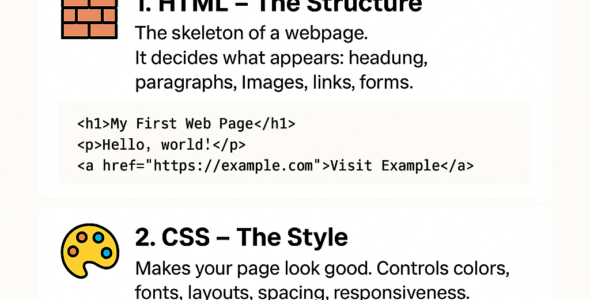In this module, we'll delve into the CSS Grid Layout Module, a powerful tool for creating responsive and flexible grid-based layouts. You'll learn about the syntax, examples, and best practices for using CSS Grid to craft complex and responsive layouts.
CSS Grid Basics
- Grid Container: The element that contains the grid items.
- Grid Items: The elements that are direct children of the grid container.
- Grid Lines: The horizontal and vertical lines that make up the grid.
- Grid Cells: The individual units of the grid, formed by the intersection of grid lines.
- Grid Areas: The rectangular regions of the grid, formed by multiple grid cells.
CSS Grid Properties
- grid-template-columns: Defines the number and size of columns in the grid.
Syntax: grid-template-columns: <track-list>
Example: grid-template-columns: repeat(3, 1fr)
- grid-template-rows: Defines the number and size of rows in the grid.
Syntax: grid-template-rows: <track-list>
Example: grid-template-rows: repeat(2, 1fr)
- grid-column-gap: Defines the gap between columns.
Syntax: grid-column-gap: <length>
Example: grid-column-gap: 10px
- grid-row-gap: Defines the gap between rows.
Syntax: grid-row-gap: <length>
Example: grid-row-gap: 10px
- grid-column: Defines the column position of a grid item.
Syntax: grid-column: <column-start> / <column-end>
Example: grid-column: 2 / 4
- grid-row: Defines the row position of a grid item.
Syntax: grid-row: <row-start> / <row-end>
Example: grid-row: 1 / 3
- grid-area: Defines the grid area of a grid item.
Syntax: grid-area: <grid-area-name>
Example: grid-area: header
Examples
- Create a simple grid layout with two columns and three rows:
.grid {
grid-template-columns: repeat(2, 1fr);
grid-template-rows: repeat(3, 1fr);
grid-column-gap: 10px;
grid-row-gap: 10px;
}
- Place a grid item in the second column and third row:
.item {
grid-column: 2;
grid-row: 3;
}
- Create a grid layout with a header, footer, and sidebar:
.grid {
grid-template-columns: 200px 1fr;
grid-template-rows: 50px 1fr 50px;
grid-template-areas:
"header header"
"sidebar main"
"footer footer";
}
Best Practices
- Use CSS Grid to create responsive and flexible layouts.
- Use grid-template-columns and grid-template-rows to define the grid structure.
- Use grid-column-gap and grid-row-gap to add spacing between grid items.
- Use grid-column and grid-row to position grid items.
- Use grid-area to define grid areas.
- Test your grid layouts in different browsers and devices to ensure compatibility.
By mastering CSS Grid, you'll be able to create complex and responsive grid-based layouts with ease.

